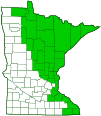fan clubmoss
(Diphasiastrum digitatum)
Conservation • Description • Habitat • Ecology • Use • Distribution • Taxonomy
Conservation Status |
|
|||||||
| IUCN Red List | not listed |
|||||||
| NatureServe | N5 - Secure SNR - Unranked |
|||||||
| Minnesota | not listed |
|||||||
Description |
||
There are seventeen species of Diphasiastrum worldwide, five in North America, two in Minnesota. Fan clubmoss (Diphasiastrum digitatum) occurs in North America east of the Great Plains. It is the most abundant Diphasiastrum species in North America. It is common in eastern and north-central Minnesota. It grows in well-drained, moist to dry soil, in dappled sunlight to light shade, in open, upland, coniferous and deciduous woodlands, thickets, and sandy fields. Fan clubmoss is an erect, evergreen, perennial club moss. It produces long-creeping, sparingly-branched, horizontal stems (rhizomes) that lie on the surface of the soil. The rhizomes are light green, hairless, round in cross section, and 1 ⁄32″ to ⅛″ (1.3 to 2.7 mm) in diameter. They are sparsely to moderately covered with tiny, scale-like leaves that often drop off. These leaves are, dry, thin, somewhat transparent, and appressed to spreading. They are narrowly pointed at the tip, linear to narrowly lance-shaped, 1 ⁄16″to 3 ⁄16″ (1.8 to 4.5 mm) long, and 1 ⁄32″ (0.6 to 1.2 mm) wide. Fibrous roots emerge from the underside of the rhizomes. Upright shoots appear at intervals on the upper side of the rhizomes. The shoots can be 6″ to 20″ (15 to 50 cm) tall but fertile shoots, those with cone-like spore-bearing structures (strobili), are usually less than 12″ in height, and vegetative shoots, those without strobili, are usually less than 8″ in height. The stem is round, hairless, and moderately covered with appressed to slightly spreading, scale-like leaves. These leaves are awl-shaped, 1 ⁄16″ to ⅛″ (1.8 to 3.5 mm) long, and 1 ⁄32″ (0.6 to 1.0 mm) wide. They are narrowly pointed at the tip and continue down the stem at the base. Each stem has two or more branches near the base. The branches ascend from the stem then spread horizontally, more or less parallel to the ground and on the same plane, sometimes beneath the forest litter (duff layer). The stem and branches almost never have narrow areas marking the start and end of annual growth (annual constrictions). Each branch forks up to three times. The ultimate branchlets are ⅛″ (2.8 to 3.9 mm) wide. They are flat, green, and shiny above, flat, pale, and dull below. There are four ranks of leaves, one on the flat upper side, one on the flat underside, and one on each narrow side. The lateral leaves are the largest. They are appressed to spreading, ⅛″ to 3 ⁄16″ (3.1 to 5.5 mm) long, and 1 ⁄32″ to 1 ⁄16″ (1 to 2 mm) wide. The leaves on the upper side are liner lance-shaped and appressed. The free tip of the blade is no more than 1 ⁄32″ (1.5 mm) long. The leaves on the underside are the smallest and are poorly developed. They are spreading, narrowly triangular, and no more than 1 ⁄32″ (1 mm) long. At the end of each fertile shoot two upright stalks (peduncles) emerge with a cluster of 2 to 4, rarely more, strobili at the tip. The peduncles are 1¾″ to 6″ long, hairless, round in cross section, and conspicuously leafy. These leaves are somewhat whorled, linear lance shaped to nearly thread-like, and no more than ⅛″ (3.3 mm) long. The strobili are on short branches that appear whorled but are actually at the end of minute forks at the tip of the peduncle. They are often arranged as two pairs. Each strobilus is light green, narrowly cylinder-shaped, 9 ⁄16″ to 1 9 ⁄16″ (14 to 40 mm) long, and 1 ⁄16″ to ⅛″ (2 to 3 mm) wide. About half of the strobili have a short, up to 7 ⁄16″ (11 mm) long sterile tip. The strobili are densely covered with small, scale-like bracts (sporophylls). Each sporophyll is triangular and 1 ⁄16″ to ⅛″ (1.7 to 2.8 mm) long and wide. A single kidney-shaped spore-bearing structure (sporangia) is hidden beneath each sporophyll. The sporangia split open and the spores are released in late summer to fall. The spores are dispersed by wind. |
||
Height |
||
6″ to 20″ |
||
Similar Species |
||
Habitat |
||
Well-drained moist to dry. Open, upland, coniferous and deciduous woodlands; thickets; and sandy fields. Dappled sunlight to light shade. |
||
Ecology |
||
Flowering |
||
Late summer to fall |
||
Pests and Diseases |
||
|
||
Use |
||
|
||
Distribution |
||||
|
Sources |
|||
| 4/14/2023 | ||||
Nativity |
||||
Native |
||||
Occurrence |
||||
Common in eastern North America and in eastern Minnesota |
||||
Taxonomy |
|||
| Kingdom | Plantae (Plants) | ||
| Subkingdom | Pteridobiotina | ||
| Phylum | Tracheophyta (Vascular Plants) | ||
| Subdivision | Lycopodiophytina | ||
| Class | Lycopodiopsida | ||
| Subclass | Lycopodiidae | ||
Order |
Lycopodiales (clubmosses and firmosses) | ||
Family |
Lycopodiaceae (clubmosses and firmosses) | ||
| Subfamily | Lycopodioideae | ||
Genus |
Diphasiastrum (ground cedars) | ||
Club mosses in the genus Diphasiastrum readily crossbreed with other species in the same genus. The hybrids that are produced are fertile. Fertile hybrids are common in the animal kingdom but rare in the plant kingdom. |
|||
Subordinate Taxa |
|||
|
|||
Synonyms |
|||
Diphasium complanatum ssp. flabelliforme Lycopodium complanatum var. flabelliforme Lycopodium digitatum Lycopodium flabelliforme Lycopodium flabelliforme var. ambiguum |
|||
Common Names |
|||
crowfoot club-moss fan clubmoss southern ground-cedar southern groundcedar southern running-pine |
|||
Glossary
Linear
Long, straight, and narrow, with more or less parallel sides, like a blade of grass.
Rhizome
A horizontal, usually underground stem. It serves as a reproductive structure, producing roots below and shoots above at the nodes.
Sporangium
A spore bearing structure, as of a fern, moss, or slime mold. Plural: sporangia.
Sporophyll
A modified leaf that bears one or more sporangia.
Strobilus
A cone-like structure of horsetails (Equisetaceae) and clubmosses (Lycopodiaceae) composed of sporophylls densely arranged along a central axis. Plural: strobili.
Visitor Photos |
|||||
Share your photo of this plant. |
|||||
| This button not working for you? Simply email us at info@MinnesotaSeasons.com. Attach one or more photos and, if you like, a caption. |
|||||
Luciearl |
|||||
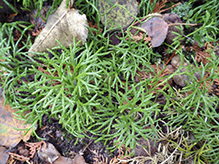 |
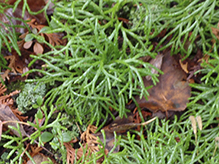 |
||||
MinnesotaSeasons.com Photos |
|||||
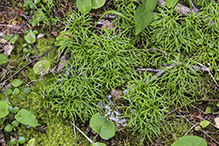 |
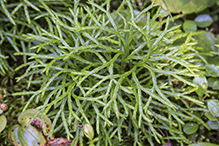 |
||||
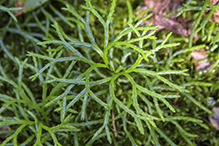 |
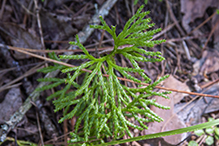 |
||||
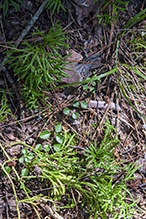 |
|||||

Slideshows |
||

Visitor Videos |
|||
Share your video of this plant. |
|||
| This button not working for you? Simply email us at info@MinnesotaSeasons.com. Attach a video, a YouTube link, or a cloud storage link. |
|||
Other Videos |
|||
| Southern running-pine, Diphasiastrum digitatum, releases spores. Robert Klips |
|||
About
Sep 8, 2011 Why on earth would someone gather clubmoss spores? Because they're flammable, in a fun way. Tossed onto a candle flame, they ignite with a bright flash. Introductory biology teachers at regional campuses of great mid-western Universities have been known to do this in class, to illustrate the former use of clubmoss spores in early flash photography. The video below shows: (1) that spores are indeed produced within the strobili, and also includes (2) a short "fair use" excerpt from the 1960 Spencer Tracy movie about the Scopes Monkey Trial, "Inherit the Wind," depicting courtroom photographers using flash powder. |
|||

Created: 11/3/2019
Last Updated:
